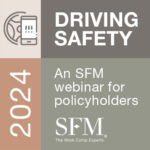May 9, 2024
Safe driving practices for employees
 Nearly 43,000 Americans died in car crashes in 2022, a number that has been on the rise in recent years.
Nearly 43,000 Americans died in car crashes in 2022, a number that has been on the rise in recent years.
It is a grim reminder that adopting safe driving practices can be lifesaving.
Safe driving habits
Defensive driving and other safe driving techniques are learned habits. Here are some tips to help equip employees and yourself with the knowledge you need to be safer on the roads.
Identify the following common hazards and actively avoid them:
- Changing road or traffic conditions. Adjust your driving to match the traffic around you, and the weather and road conditions.
- Impaired driving. Never drive with alcohol or drugs in your system and keep an eye out for other drivers that may be impaired.
- Distractions, such as food, maps, and cell phones. Avoid distractions that take your attention away from driving or your hands off the wheel. Pull over and stop if you need to text or make a call.
- Driving while sleepy or drowsy. Pull over and rest if you are tired.
Adopt the safe driving procedures:
- Always wear your seatbelt.
- Drive at a speed safe for the weather conditions. Snow and rain may warrant slowing down below the posted limits.
- Maintain space between your vehicle and the vehicle in front of you. A safe margin is 2-4 seconds when weather and traffic conditions are ideal, and longer if conditions are slippery or traffic is congested. Commercial vehicles should always maintain a 4-plus second space in front of their vehicle.
- Regularly glance two to three vehicles ahead of you, behind you and to your sides, and use your mirrors to check blind spots.
- Look left, right and left again before entering an intersection.
- Ensure the path is clear, even if you have the right of way at an intersection.
- Maintain an escape route in case of an unexpected event.
Company cellphone policy
Cellphone use is a major contributor to distracted driving and therefore driving-related injuries and deaths. The National Safety Council reports that nearly 12 percent of fatal crashes in in 2021 involved cellphone use.
Meanwhile, 34 states bar people from using hand-held cellphones while driving, and only one state does not prohibit people from texting and driving, according to the Governors Highway Safety Association .
Company policy should address cellphone use if you have employees whose job includes driving. Not only does it help keep employees safe, but it could help your organization’s bottom line. The National Safety Council reports that employers have been held liable for crashes caused by employee cell phone use, including the use of hands-free devices.
SFM provides a sample cellphone policy CompTalk in our Resource Catalog. This example policy prohibits any use of phones while driving for work, regardless of an employee’s use of hands-free devices. It requires employees pull over and stop before calling, answering, or texting using a cellphone.
Employee training
After establishing company-supported safe driving practices and a cell phone policy, be sure to train employees on them and follow up regularly to ensure employees are following the guidelines.
Lastly, SFM also offers training tools on defensive driving and cellphone use in our Resource Catalog.





